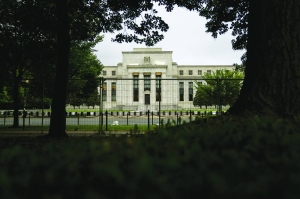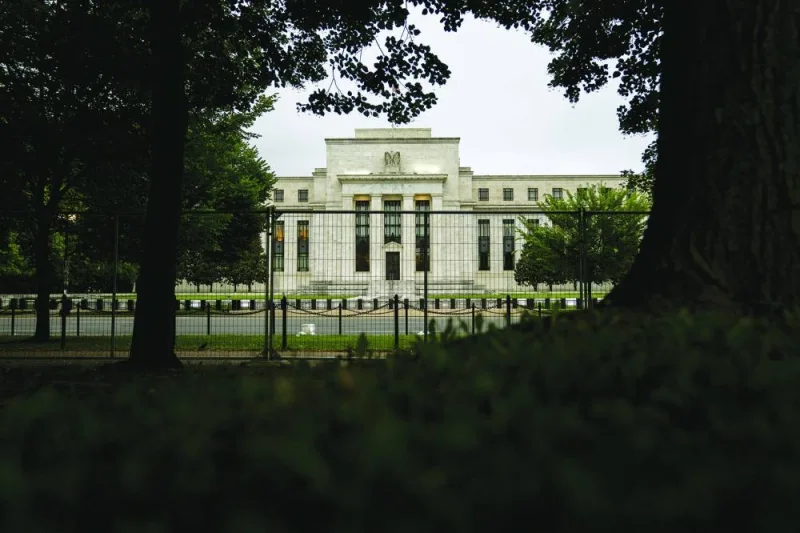Global South
Quantitative tightening goes global for first time, in test for markets


The Federal Reserve building in Washington, DC. After having sailed through uncharted waters repeatedly over the past two decades, the developed world’s top central banks are entering a new stretch: For the first time, they’re engaging in joint quantitative tightening.
After having sailed through uncharted waters repeatedly over the past two decades, the developed world’s top central banks are entering a new stretch: For the first time, they’re engaging in joint quantitative tightening (QT).
Last month’s decision by the Bank of Japan (BoJ) to steadily shrink its portfolio of bond holdings in coming years means it’s now engaging in balance-sheet contraction alongside the Federal Reserve, European Central Bank (ECB) and Bank of England (BoE). While QT, as it’s known, is different in each jurisdiction, it involves a withdrawal of the liquidity that central bankers pumped into their economies during the pandemic crisis by buying bonds.
When the Fed conducted QT for the first time, policymakers were blindsided by unanticipated disruptions to money markets in 2019. While Chair Jerome Powell has said the Fed learned lessons from that, and pledged a halt before trouble emerges, there’s no guarantee for smooth sailing — particularly now that investors are facing a global drain on cash.
“Problems could arise again at the Fed, while other central banks have not been tested yet,” said Steven Barrow, who’s worked as a foreign-exchange and fixed-income strategist for four decades and serves as head of G10 strategy at Standard Bank in London.
Many on Wall Street anticipate the Fed’s QT programme only has months to go, as the US central bank shifts to cutting interest rates to help support the economy. The Fed already in June eased the pace at which it’s shrinking its bond portfolio.
At last month’s policy meeting, “several” policymakers stressed the importance of monitoring money market conditions as the Fed continues to reduce its balance sheet, minutes of that gathering showed on Wednesday.
Indeed, recent signs of pressures in funding markets have reinforced expectations for the Fed to bring its programme to an end. Barrow also wrote in a recent note to clients that the selloff in global stocks that reached a crescendo on August 5 with the worst slide since 2020 might have been a warning sign for potential QT reverberations.
“Bond purchases by central banks in earlier years plied economies with cash, and part of that was used to invest in riskier assets such as equities,” Barrow wrote. “But now these central bank asset piles are being reduced and that presents a challenge for investors.”
The 2019 episode in the US saw a severe shortage of funding in the vital repurchase agreement market, forcing a sudden shift by the Fed. That very experience gives many central bank watchers confidence that policymakers will modify their balance-sheet policies as needed to avert any major threat to financial stability.
The UK provides a more recent case study. In 2022, the BoE delayed the start of its sales programme due to turmoil in the UK bond market initially triggered by former prime minister Liz Truss’s fiscal plans. Such was the volatility that the central bank ended up briefly buying gilts again under its financial-stability mandate.
Once the worst of the turbulence ended, though, the BoE proceeded with its sales programme. It initially excluded the long-dated debt at the heart of the market turmoil — in a sign that QT programmes can be adapted so as to minimise market impact.
“It is true all central banks that had conducted QE in the past are doing QT,” said Sayuri Shirai, a former BoJ board member. “While the appropriate size of the balance sheets is not clear, markets know central banks will always stop and/or adjust their QT programmes, as was the case in the 2022 October UK mini-budget turmoil.”
Shirai, a professor of economics at Keio University in Tokyo, also noted that many central banks are now lowering interest rates. That should help limit any downward pressure on bond prices from QT, she said.
The main advanced-economy central banks are in varying stages of QT, with the Fed widely expected to quit its programme in the coming months, and the BoJ only just kicking off its own initiative.
While bank reserves parked at the Fed appear sizeable at around $3.3tn, some market participants have highlighted the risk of worrisome cracks appearing, similar to those seen five years ago — arguing for a near-term end to QT. Meantime, if acute funding pressures did suddenly emerge, the Fed today has liquidity backstops that it didn’t have back in 2019 to address such a scenario.
In Europe, the ECB has stopped reinvesting some of the bonds it holds when they mature, though it still sees a need to maintain some holdings. Earlier this year, officials agreed a new policy framework involving a “structural” portfolio that will help provide liquidity to the financial system — alongside lending operations.
Like the Fed, the Bank of Canada (BoC) has been shrinking its balance sheet for more than two years now.
This year, the programme has had the effect of impairing the functioning of short-term funding markets, forcing the BoC into periodic interventions.
Nevertheless, Deputy Governor Carolyn Rogers said last month indicated the bank would keep going with QT for now because the balance sheet wasn’t yet “normalised.”
Even more determined on normalisation is the BoE, which has taken the most aggressive approach — actively selling off bonds from its portfolio, not just reinvesting fewer maturing securities.
To address any market liquidity issues, it’s encouraging banks to use a range of lending facilities to get cash from the BoE as needed — known as a demand-driven system.
“The BoE remains in our view the most determined to pursue the demand-driven reserve system,” said Jakub Lichwa, a portfolio manager at TwentyFour Asset Management. “Eventually, we believe the market will adjust to the concept of central banks providing funding directly to the banking sector in the normal course of business.”
Japan is a newcomer to QT. Last month, the BoJ announced a programme to scale down its purchases, with the expectation that holdings will shrink by 7% to 8% over a little less than two years — taking the amount of maturing bonds into account. Citigroup Inc estimates a ¥10tn ($69bn) drop by the end of March 2025.
Last month’s decision by the Bank of Japan (BoJ) to steadily shrink its portfolio of bond holdings in coming years means it’s now engaging in balance-sheet contraction alongside the Federal Reserve, European Central Bank (ECB) and Bank of England (BoE). While QT, as it’s known, is different in each jurisdiction, it involves a withdrawal of the liquidity that central bankers pumped into their economies during the pandemic crisis by buying bonds.
When the Fed conducted QT for the first time, policymakers were blindsided by unanticipated disruptions to money markets in 2019. While Chair Jerome Powell has said the Fed learned lessons from that, and pledged a halt before trouble emerges, there’s no guarantee for smooth sailing — particularly now that investors are facing a global drain on cash.
“Problems could arise again at the Fed, while other central banks have not been tested yet,” said Steven Barrow, who’s worked as a foreign-exchange and fixed-income strategist for four decades and serves as head of G10 strategy at Standard Bank in London.
Many on Wall Street anticipate the Fed’s QT programme only has months to go, as the US central bank shifts to cutting interest rates to help support the economy. The Fed already in June eased the pace at which it’s shrinking its bond portfolio.
At last month’s policy meeting, “several” policymakers stressed the importance of monitoring money market conditions as the Fed continues to reduce its balance sheet, minutes of that gathering showed on Wednesday.
Indeed, recent signs of pressures in funding markets have reinforced expectations for the Fed to bring its programme to an end. Barrow also wrote in a recent note to clients that the selloff in global stocks that reached a crescendo on August 5 with the worst slide since 2020 might have been a warning sign for potential QT reverberations.
“Bond purchases by central banks in earlier years plied economies with cash, and part of that was used to invest in riskier assets such as equities,” Barrow wrote. “But now these central bank asset piles are being reduced and that presents a challenge for investors.”
The 2019 episode in the US saw a severe shortage of funding in the vital repurchase agreement market, forcing a sudden shift by the Fed. That very experience gives many central bank watchers confidence that policymakers will modify their balance-sheet policies as needed to avert any major threat to financial stability.
The UK provides a more recent case study. In 2022, the BoE delayed the start of its sales programme due to turmoil in the UK bond market initially triggered by former prime minister Liz Truss’s fiscal plans. Such was the volatility that the central bank ended up briefly buying gilts again under its financial-stability mandate.
Once the worst of the turbulence ended, though, the BoE proceeded with its sales programme. It initially excluded the long-dated debt at the heart of the market turmoil — in a sign that QT programmes can be adapted so as to minimise market impact.
“It is true all central banks that had conducted QE in the past are doing QT,” said Sayuri Shirai, a former BoJ board member. “While the appropriate size of the balance sheets is not clear, markets know central banks will always stop and/or adjust their QT programmes, as was the case in the 2022 October UK mini-budget turmoil.”
Shirai, a professor of economics at Keio University in Tokyo, also noted that many central banks are now lowering interest rates. That should help limit any downward pressure on bond prices from QT, she said.
The main advanced-economy central banks are in varying stages of QT, with the Fed widely expected to quit its programme in the coming months, and the BoJ only just kicking off its own initiative.
While bank reserves parked at the Fed appear sizeable at around $3.3tn, some market participants have highlighted the risk of worrisome cracks appearing, similar to those seen five years ago — arguing for a near-term end to QT. Meantime, if acute funding pressures did suddenly emerge, the Fed today has liquidity backstops that it didn’t have back in 2019 to address such a scenario.
In Europe, the ECB has stopped reinvesting some of the bonds it holds when they mature, though it still sees a need to maintain some holdings. Earlier this year, officials agreed a new policy framework involving a “structural” portfolio that will help provide liquidity to the financial system — alongside lending operations.
Like the Fed, the Bank of Canada (BoC) has been shrinking its balance sheet for more than two years now.
This year, the programme has had the effect of impairing the functioning of short-term funding markets, forcing the BoC into periodic interventions.
Nevertheless, Deputy Governor Carolyn Rogers said last month indicated the bank would keep going with QT for now because the balance sheet wasn’t yet “normalised.”
Even more determined on normalisation is the BoE, which has taken the most aggressive approach — actively selling off bonds from its portfolio, not just reinvesting fewer maturing securities.
To address any market liquidity issues, it’s encouraging banks to use a range of lending facilities to get cash from the BoE as needed — known as a demand-driven system.
“The BoE remains in our view the most determined to pursue the demand-driven reserve system,” said Jakub Lichwa, a portfolio manager at TwentyFour Asset Management. “Eventually, we believe the market will adjust to the concept of central banks providing funding directly to the banking sector in the normal course of business.”
Japan is a newcomer to QT. Last month, the BoJ announced a programme to scale down its purchases, with the expectation that holdings will shrink by 7% to 8% over a little less than two years — taking the amount of maturing bonds into account. Citigroup Inc estimates a ¥10tn ($69bn) drop by the end of March 2025.







